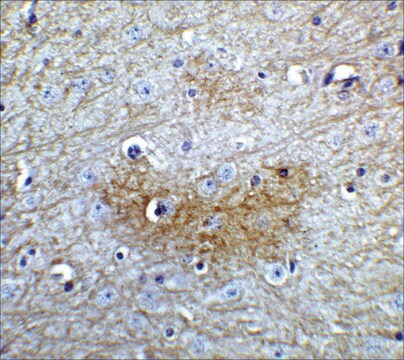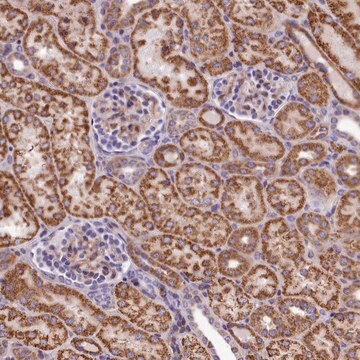일반 설명
We are committed to bringing you greener alternative products, which adhere to one or more of The 12 Principles of Green Chemistry.This antibody is Preservative-free, produced without the harm or sacrifice of animals and exceptionally stable to allow for ambient shipping and storage if needed and thus aligns with "Waste Prevention", "Designing Safer Chemicals" and "Design for Energy Efficiency".
Click here for more information.
ZooMAb® antibodies represent an entirely new generation of recombinant monoclonal antibodies.Each ZooMAb® antibody is manufactured using our proprietary recombinant expression system, purified to homogeneity, and precisely dispensed to produce robust and highly reproducible lot-to-lot consistency. Only top-performing clones are released for use by researchers. Each antibody is validated for high specificity and affinity across multiple applications, including its most commonly used application. ZooMAb® antibodies are reliably available and ready to ship when you need them.
특이성
Clone 3G12 is a ZooMAb® Rabbit recombinant monoclonal antibody that specifically detects GLS2. It targets an epitope with in 22 amino acids from the N-terminal region.
면역원
KLH-conjugated linear peptide corresponding to 22 amino acids from the N-terminal region of human Glutaminase liver isoform, mitochondrial (GLS2).
애플리케이션
Quality Control Testing
Evaluated by Western Blotting in HepG2 cell lysate.
Western Blotting Analysis: 1:1,000 dilution of this antibody detected GLS2 in HepG2 cell lysate.
Tested applications
Western Blotting Analysis: 1:1,000 dilution from a representative lot detected GLS2 in rat liver, human liver, and human brain tissue lysate.
Flow Cytometry Analysis: 1 μg from a representative lot detected GLS2 in one million HepG2 cells.
Immunocytochemistry Analysis: A 1:100 dilution from a representative lot detected GLS2 in HepG2 cells.
Affinity Binding Assay: A representative lot of this antibody bound GLS2 with a KD of 4.3 x 10-6 in an affinity binding assay.
Note: Actual optimal working dilutions must be determined by end user as specimens, and experimental conditions may vary with the end user
Anti-GLS2, clone 3G12 ZooMAb®, Cat. No. ZRB1473, is a recombinant Rabbit monoclonal antibody that specifically detects GLS2 (L-glutaminase) and is tested for use in Affinity Binding Assay, Flow Cytometry, Immunocytochemistry, and Western Blotting.
표적 설명
Glutaminase liver isoform, mitochondrial (UniProt: Q9UI32; also known as EC:3.5.1.2, GLS, L-glutaminase, LGA, L-glutamine amidohydrolase, GLS2) is encoded by the GLS2 (also known as GA) gene (Gene ID: 27165) in human. Glutaminase, a key metabolic enzyme that hydrolyzes glutamine to glutamate and ammonia, is expressed as either kidney type (GLS) or liver type (GLS2). GLS2 is a homotetrameric protein that exists as a long and a short isoform and the long isoform is localized to the mitochondria. A third variant, which is much shorter than the others has also been reported, but it lacks the glutaminase catalytic domain. Although GLS2 is predominant in the liver, its expression has also been reported in the brain and pancreas. It promotes mitochondrial respiration and increases ATP generation in cells by catalyzing the synthesis of glutamate and a-ketoglutarate. It also increases cellular antioxidant function via NADH and glutathione production. Both kidney and liver glutaminases are activated by phosphate. However, GLS2 is activated by lower concentrations of phosphate than GLS, but phosphate is ultimately able to increase GLS catalytic activity by a greater magnitude than for GLS2. In addition, GLS2 is also activated by ammonia, whereas ammonia inhibits GLS. High expression of GLS2 has been reported in a variety of human cancers, including bladder, breast, cervix, colon, kidney, liver, and lung. Inhibition or genetic silencing of GLS2 is shown to diminish the growth of A549 and HepG2 hepatoma cells. This ZooMAb® recombinant monoclonal antibody, generated by our propriety technology, offers significantly enhanced specificity, affinity, reproducibility, and stability over conventional monoclonals. (Ref.: Dias, MM., et al. (2020). Oncogene 39; 690-702; Katt, WP., et al. (2017). Future Med. Chem. 9(2); 223-243).
물리적 형태
Purified recombinant rabbit monoclonal antibody IgG, lyophilized in PBS with 5% Trehalose, normal appearance a coarse or translucent resin. The PBS/trehalose components in the ZooMAb® formulation can have the appearance of a semi-solid (bead like gel) after lyophilization. This is a normal phenomenon. Please follow the recommended reconstitution procedure in the data sheet to dissolve the semi-solid, bead-like, gel-appearing material. The resulting antibody solution is completely stable and functional as proven by full functional testing. Contains no biocide or preservatives, such as azide, or any animal by-products. Larger pack sizes provided as multiples of 25 μL.
재구성
300 μg/mL after reconstitution at 25 μL per vial. Please refer to guidance on suggested starting dilutions and/or titers per application and sample type.
저장 및 안정성
Recommend storage of lyophilized product at 2-8°C; Before reconstitution, micro-centrifuge vials briefly to spin down material to bottom of the vial; Reconstitute each vial by adding 25 μL of filtered lab grade water or PBS; Reconstituted antibodies can be stored at 2-8°C, or -20°C for long term storage. Avoid repeated freeze-thaws.
법적 정보
ZooMAb is a registered trademark of Merck KGaA, Darmstadt, Germany
면책조항
Unless otherwise stated in our catalog or other company documentation accompanying the product(s), our products are intended for research use only and are not to be used for any other purpose, which includes but is not limited to, unauthorized commercial uses, in vitro diagnostic uses, ex vivo or in vivo therapeutic uses or any type of consumption or application to humans or animals.










